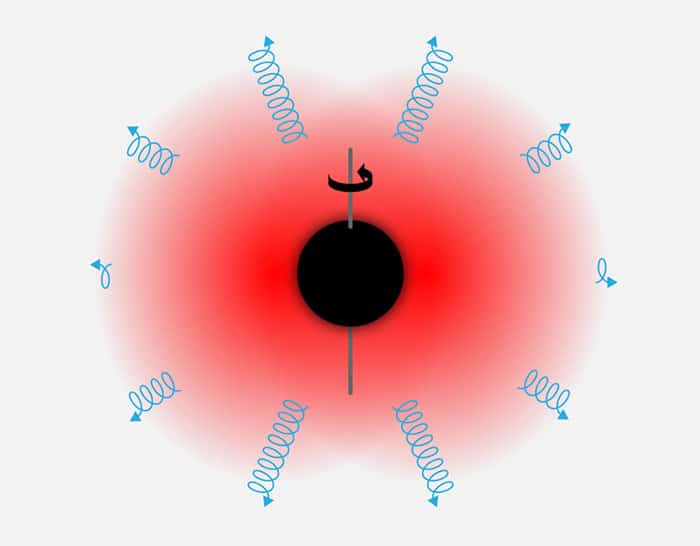
Black holes may defy the famous “no-hair” theorem by leaking residual gravitational ripples that could one day be observed by gravitational-wave detectors. Such an observation would provide evidence for physics beyond the Standard Model, according to several new lines of research.
Conventionally, black holes can be described by only three properties: their mass, their spin and their charge. Therefore, some physicists say that black holes resemble a bald head with no hair. So, if two black holes have the same mass, spin and electric charge, then in theory they should be identical.
Over the years, scientists have looked for ways around the no-hair theorem via various loopholes, one of which is the possible existence of scalar fields that could interact with a black hole. We know of one scalar field that exists, namely the Higgs field, for which the force carrier is the Higgs boson. The Higgs field, however, is unstable and decays rapidly, but other scalar fields associated with everything from dark matter and dark energy, to various strands of string theory and modified gravity, have also been posited.
The Aretakis charge
In 2011, Stefanos Aretakis, now at the University of Toronto, and colleagues, showed how a scalar field could leave a trace of its existence in the form of a perturbation on a simplified model of a non-rotating, extreme black hole (one that possesses either the maximum electric charge or spin that a black hole of its mass can have). This would give the black hole hair that they called the Aretakis charge, and it would differ from black hole to black hole.
Now, Lior Burko of Theiss Research in California, Gaurav Khanna of the University of Massachusetts and the University of Rhode Island, and Subir Sabharwal of the University of Massachusetts have shown that extreme rotating black holes could have a gravitational equivalent of the Aretakis charge. They describe their finding in Physical Review D.
“What Aretakis found through his mathematical analysis is that there is a trace of the [scalar] field left on the horizon, says Khanna. “This is the so-called Aretakis charge, and what we found is that there is a similar charge associated with the gravitational field.”
This gravitational hair originates from perturbations in the curvature of space-time at a black hole’s event horizon and is dependent upon how the black hole was formed. Since there will be differences in the exact details of how each black hole forms, it means that this gravitational hair will be different from one black hole to another, distinguishing them even when their mass, spin and charge are the same.
Hair support
Jamie Bamber, of the University of Oxford, describes the findings as looking “robust”, and that, in principle, “such a mechanism for supporting hair is feasible.” However, Bamber points out that extreme black holes are probably quite rare, if they even exist at all.

Almost certain escape from a black hole
Khanna acknowledges this but tells Physics World of the caveat that he “expects our result would hold true for black holes that are ‘near extreme”’.
Bamber, working with his Oxford colleagues Katy Clough and Pedro Ferreira, as well Lam Hui and Macarena Lagos of Columbia University in New York, has recently published a preprint on arXiv exploring a different avenue for finding black hole hair resulting from the scalar fields associated with some models of dark matter.
Black hole wig
In their model, when a cloud of dark matter accretes onto an ordinary (non-extreme) black hole, the scalar field associated with the dark matter also grows around the black hole, at a rate that is dependent upon characteristics such as the black hole’s mass and spin, or the angular momentum of the dark matter cloud. However, the scalar field would not last forever; once all the dark matter accretes, the field – and its associated hair – would disappear. Given its temporary nature, this hair is referred to as a “wig”.
What both models have in common is the possibility that their hair could be detected by gravitational-wave detectors.
“It’s something that we could measure from far away,” says Khanna. How far away remains uncertain at this point, and Khanna’s group is planning to analyse the possibilities soon.
Monochromatic waves
In the dark-matter accretion model, the gravitational-wave signal is expected to be too weak for our current generation of detectors to observe. However, if future detectors with greater sensitivity were to detect this hair, they would measure a signal that “looks like a series of monochromatic waves, with frequencies set by the scalar-field mass,” says Bamber. “These could show up as peaks on a spectrum of the gravitational-wave background.”

Spinning black holes could grow long hair
There is also the possibility that gravitational hair could be spotted during a black-hole merger. “The imprint of such clouds on a binary merger is something we are actively working on,” says Bamber. Theoretical work has shown that during the in-spiral phase as the two black holes get closer and closer, and the ring-down phase following the merger when the gravitational waves decrease, the imprint of the hair would be negligible. However, the hair could be evident during the moment where the gravitational waves are strongest.
If gravitational hair could be detected, it would provide precious insight into physics beyond the Standard Model, involving new particles associated with the scalar fields. In the case of Bamber’s model, it could provide further information about the nature of dark matter; in Burko and Khanna’s work, it would also tell us more about the history of individual black holes, which would be important for cosmologists trying to explain the origin of the supermassive black hole at the centre of most large galaxies.



